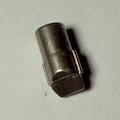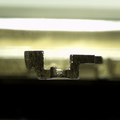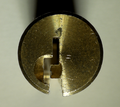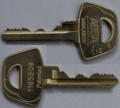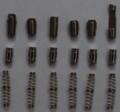ASSA d12
ASSA d12
| ASSA d12 | |
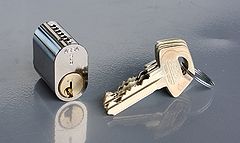 | |
| Name | ASSA d12 |
|---|---|
| Manufacturer | ASSA |
| Lock Type | Cylinder |
| Lock Design | Pin-tumbler |
| Year(s) Produced | 2010? |
| Security Rating(s) | EN 1303 |
| Specifications | |
| # of Components | 6 |
| Component Type | Pin-tumbler |
| Related Locks | |
| ASSA 700 | |
The d12 is a medium security EN 1303-rated pin tumbler cylinder made by ASSA for residential or commercial use. It is intended as a successor to the ASSA 700 series which dates back to 1948. The d12 features six pins and numerous security improvements over the original cylinder, including a paracentric keyway and patented key profiles.
There are two main models - model 13XX featuring usual six pins (also referred to as Level 1) and model 12XX featuring a checkpin interacting with the secondary bitting at the front of the key, close to its spine (referred to as Level 2).citation needed
Principles of operation
d12 key has two cuts for every keypin, which doesn't have to be at the same height. Combined with the double spiked keypins, where the spikes doesn't have the be the same height, allows some form of masterkeying, not requiring master wafers. This adds to the overall security of the lock as there doesn't have to be additional shearlines.
The Level 2 model has at least one keypin in one of the last two chambers switched for a higher checkpin, that interacts with the secondary bitting at the tip of the key.
All driver pins are ASSA barrel spools and all chambers have the matching counter-milling, which coupled with the keyway design leads to high resistance against lockpicking. All core chambers also contain two grooves, that have several functions: first of all, they ensure the keypin can't rotate, which could render the lock inoperable; the second function is to prevent bumping (or at least make it very hard) - each keypin's wings end in different heights, which causes the tops of the pins stay in different heights.
The core has two holes on both the left and the right side, that seem to be aligned with the first chamber, which would suggest the possibility of the construction keying.
Disassembly instructions
There are two main assemblies this lock can be found in which will vary by branding and format. One uses a C-clip on the back on the plug while the other uses a large retaining screw.
If the lock uses the retaining screw:
- Unscrew the Torx screw on the tailpiece and remove the wafer beneath it.
- Unscrew the retaining screw from the rear of the plug.
- Unscrew and remove the closing rod over the pin chambers (be careful not to allow springs to escape).
- Remove the driver pins and springs. They are all the same so there is no need to keep them in order. Key pins cannot fit through the top chambers.
- Slide the plug out of the housing.
Disassembly using a follower is possible but not recommended due to the threads on the back of the plug that accept the retaining screw.
If the lock uses a C-clip:
- Remove the C-clip.
- Insert the key and turn the plug 45-90 degrees.
- Withdraw the plug from the cylinder. (A plug follower is recommended)
When reassembling the lock, always check with the key if all the keypins rest at the shearline - if a pin is turned around, chances are it will be either too deep or too high, rendering the key not working.
Vulnerabilities
The ASSA d12 may be vulnerable to one or more of the following:
Gallery
References
External links
- Paper by Han Fey on ASSA d12
- ASSA d12 product page (Swedish)
- Differences between ASSA 700 and ASSA d12


